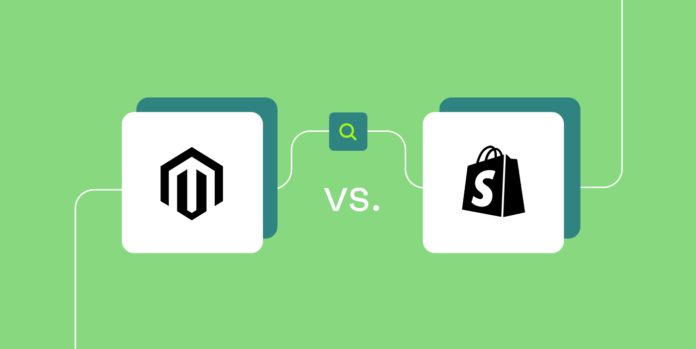
If you are the owner of a retail store and have not sold online until now, the situation surrounding Covid-19 has probably made you think about opening your online store. And we’re sure you’re not alone in that.
A large number of stores around the world were unable to sell their goods through traditional retail during the quarantine, so an online store seems like the perfect solution for survival in times of crisis. However, the online store is much more than an antidote to the crisis caused by this pandemic. It opens the door to a much larger market, where opportunities are countless.
Once you decide to move your retail activity online, the question of how and where arises. When it comes to the first question, for more details check IT Delight. Where is something you can get confused about since so many platforms are present online. This article will compare the two most popular platforms, and make it easier to decide which one will answer your needs best. These are Shopify and Magento.
Main features and usability of these platforms

Magento. A platform that is certainly a champion in its class. According to the research it has shown to be one of the best CMS platforms for online stores among business owners around the world. It currently offers 2 editions according to the business needs: an open-source edition and a commerce edition.
The size and popularity of this platform are best illustrated by the fact that merchants from all over the world have sold goods and services worth more than 150 billion dollars through it! Also, about 30% of all e-commerce transactions are made via this platform.
Shopify. One of the leading e-commerce companies in the world. Currently, the platform services are used by more than a million online businesses around the world, that is, around 20% of e-commerce stores, and that number is increasing rapidly.
Scalability
This largely depends on the size of your business. For example, Shopify is a perfect solution for smaller ones, with not so many product lines. On the other hand, Magento will be a great solution if you’re dealing with a large number of products, of various types. Also, do consider whether you plan to expand on one point, because this will also influence the choice of the platform, making Magento a better one.
Inventory
Shopify. When it comes to the size of your inventory you can choose between two options. The starter plan option will give you a limited number of items (up to 25). However, there are also advanced options that will allow a limitless number of items.
Magento. One of the perks of this platform is the fact that they do not have a limit when it comes to the number of items. But there’s one catch. The speed and the performance of your host server will dictate how you manage your inventory.
Payment options
Shopify. As for payment options given to the consumer, this platform has a visible advantage, as it supports more than 65 different gateways. Credit cards are accepted without third-party websites having to interfere, making it easy to access the store wherever. Having a faster check-out experience makes customers way more satisfied.
Magento on the other hand also has a connection to many different gateway vendors, and integration of payment options shouldn’t be an issue.
Shopify and Magento can both be used to implement punchout catalogs using connectors and plugins. A punchout catalog is a software tool that allows a business to integrate its eCommerce platform with a customer’s eProcurement system. This enables customers to browse and purchase products from the business’s website while still using their own system to complete the transaction.
Both Magento and Shopify offer multiple connectors and plugins that can connect their platforms using the cXML standards to any eProcurement system to be able to implement Punchout.
Themes and templates

When it comes to these, options are varied on both platforms and can be chosen between free and paid ones. As for the prices of the paid ones, one can spend anything from a couple of dollars to a couple of hundred dollars. It may seem like a lot of money, but keep in mind that the owners of Magento, for example, have made sure each and every theme is unique in design, adapted for smartphones, etc.
Also, this is a very important feature for a store as its success will largely depend on it.
Apps and extensions
Both platforms offer plenty of extensions and apps, but Magento offers a bit more when it comes to the number of different ones you can choose from. The difference is uploading them on the platform can be very different, however, and Shopify has an advantage here. It also has them classified in different categories, and some of them can really upgrade your shopping cart with the ability to increase sales as well.
Marketing and SEO
Magento. One thing this platform can brag about is the scores when it comes to its SEO features. They are between 90 and 95. You can choose from a variety of cool features when it comes to this, to make the most out of your sales.
Shopify is also one of the tops when it comes to this feature. However, it is slightly better adapted to social platforms.
Customer support and community

Shopify. Excellent responsiveness when it comes to these criteria. Whether you need to reach them via phone or live chat. But in order to prevent the need for contact, they have a very detailed list of resources answering most of the questions you may be struggling with.
Magento. Although it doesn’t have customer support, there is a huge community of developers available to help you at any point, with any problem you may have. As for the resources, a forum is available to share, ask, read, and seek help if needed. It’s important to mention that those using this platform can use their technical support if they chose the enterprise edition.
How to find a migration specialist?
So, finally, you’re probably wondering how you can migrate to one of these platforms with minimal hassle. The smartest option would be to choose a migration specialist as it will make the migration smooth and cost-effective. You want to make sure all your data are transferred safely, so make sure you hire a reputable company for this task. This can easily be done by reading reviews and choosing according to the satisfied client’s experiences.
Conclusion
After reading all the above, one can conclude that both of the platforms are products of super high quality. We have provided you with enough information to choose according to your needs, possibilities, and business ambition.














